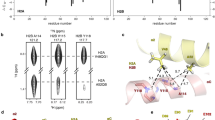Abstract
Human haemoglobin has long been a paradigm for cooperative ligand binding and allostery. Through analysis of the crystal structures of deoxyhaemoglobin and liganded haemoglobin, Perutz proposed a model for cooperativity in which the bond between the proximal histidine and the protein couples haem rearrangements to protein structure rearrangements. Here we test this model by deleting the bonds between the histidine imidazole side chain and the polypeptide. This detachment method allows us to determine directly the contribution of proximal histidine coupling to cooperativity of distal ligand binding. Proximal detachment significantly increases ligand affinity, reduces cooperativity, and prevents quaternary structure switching, in accord with the Perutz model. Residual cooperativity indicates that additional haem communication pathways exist that do not involve the proximal histidine coupling mechanism.
This is a preview of subscription content, access via your institution
Access options
Subscribe to this journal
Receive 12 print issues and online access
$209.00 per year
only $17.42 per issue
Buy this article
- Purchase on SpringerLink
- Instant access to full article PDF
Prices may be subject to local taxes which are calculated during checkout
Similar content being viewed by others
References
Wyman, J. & Gill, S.J. Binding and Linkage: Functional Chemistry of Biological Macromolecules. University Science Books, Mill Valley CA (1990).
Perutz, M.F. Mechanisms of cooperativity and allosteric regulation in proteins. Cambridge University Press, Cambridge England (1990).
Bohr, C. Zentralbl. Physiol. 17, 682 (1903).
Hill, A.V. The possible effects of aggregation of the molecules of haemoglobin on its dissociation curve. J. Physiol. 40, iv–vii (1910).
Antonini, E. & Brunori, M. Hemoglobin and Myoglobin in Their Reactions With Ligands, North-Holland Publishing Co., Amsterdam (1971).
Imai, K. Allosteric effects in haemoglobin, Cambridge University Press, New York (1982).
Cullis, A.F., Muirhead, H., Perutz, M.F. & Rossmann, M.G. Proc. Roy. Soc. A 265, 161–187 (1962).
Perutz, M.F., Muirhead, H., Cox, J.M. & Goaman, L.C.G. Three-dimensional fourier synthesis of horse oxyhaemoglobin at 2.8 Å resolution: the atomic model. Nature 219, 131–139 (1968).
Dickerson, R.E. & Geis, I. Hemoglobin. The Benjamin/Cummings Publishing Company, Inc., Menlo Park, California (1983).
Perutz, M.F. Stereochemistry of cooperative effects in haemoglobin. Nature 228, 726–734 (1970).
Perutz, M.F. Hemoglobin Structure and Respiratory Transport. Sci. Amer. 239, 92–125 (1978).
Warshel, A. Energy-structure correlation in metalloporphyrins and the control of oxygen binding in hemoglobin. Proc. Natl. Acad. Sci. USA 74, 1789–1793 (1977).
Gelin, B.R. & Karplus, M. Mechanism of tertiary structural change in hemoglobin. Proc. Natl. Acad. Sci. USA 74, 801–805 (1977).
Baldwin, J. & Chothia, C. Hemoglobin: The structural changes related to ligand binding and its allosteric mechanism. J. Mol. Biol. 129, 175–220 (1979).
Vuk-Pavlovic, S. Evolution of the haem-haem interaction in vertebrate haemoglobins-a hypothesis. J. Mol. Evol. 6, 209–214 (1975).
Barrick, D. Replacement of the proximal ligand of sperm whale myoglobin with free imidazole in the mutant His93→Gly. Biochemistry 33, 6546–6554 (1994)
DePillis, G.D., Decatur, S.M., Barrick, D. & Boxer, S.G. Functional cavities in proteins. A general method for proximal ligand substitution in myoglobin. J. Am. Chem. Soc. 116, 6981–6982 (1994).
Lu, Y., Casmiro, D.R., Bren, K.L., Richards, J.H. & Gray, H.B. Structurally engineered cytochromes with unusual ligand-binding properties: expression of Saccharomyces cerevisiae Met-80→Ala iso-1-cytochrome c. Proc. Natl. Acad. Sci. USA 90, 11456–11459 (1993).
McRee, D.E., Jesen, G.M., Fitzgerald, M.M., Siegel, H.A. & Goodin, D.B. Construction of a bisaquo heme enzyme and binding by exogenous ligands. Proc. Natl. Acad. Sci. USA 91, 12847–12851 (1994).
Wilks, A., Sun, J., Loehr, T.M. & Ortiz de Montellano, P.R. Heme oxygenase His25Ala mutant: replacement of the proximal histidine iron ligand by exogenous bases restores the catalytic activity. J. Am. Chem. Soc. 117, 2925–2926 (1995).
Newmyer, S., Sun, J., Loehr, T.M. & Ortiz de Montellano, P.R. Rescue of the Horseradish Peroxidase His-170→Ala Mutant Activity by Imidazole: Importance of Proximal Ligand Tethering. Biochemistry 35, 12788–12795 (1996).
Barrick, D. Depletion and replacement of protein metal ligands. Curr. Op. Biotechnology 6, 411–418 (1995).
St. George, R.C.C. & Pauling, L. The combining power of hemoglobin for alkyl isocyanides, and the nature of the heme-heme interactions in hemoglobin. Science 114, 629–634 (1951).
Reisberg, P.I. & Olson, J.S. Equilibrium binding of alkyl isocyanides to human hemoglobin. J. Biol. Chem 255, 4144–4150 (1980).
Reisberg, P.I. & Olson, J.S. Kinetic and cooperative mechanisms of ligand binding to hemoglobin. J. Biol. Chem 255, 4159–4169 (1980).
Mims, M.P. et al. Proton nuclear magnetic resonance studies of isonitrile-heme protein complexes. J. Biol. Chem. 258, 6125–6134 (1983).
Dahlquist, F.W. The meaning of Scatchard and Hill plots. Meth. Enzymol. 48, 270–299 (1978).
Pulsinelli, P.D., Perutz, M.F. & Nagel, R.L. Structure of Hemoglobin M Boston, a Variant with a Five-Coordinated Ferric Heme. Proc. Acad. Sci. USA 70, 3870–3874 (1973).
Takahashi, S., Lin, A.K.-L.C. & Ho, C. Proton nuclear magnetic resonacne studies of hemoglobins M. Boston (α58E7 His→Tyr) and M Milwaukee (β67E11 Val→Glu): spectral assignments of hyperfine-shifted proton resonances and of proximal histidine (E7) NH resonances to the α and β chains of normal human adult hemoglobin. Biochemistry 19, 5196–5202 (1980).
Monod, J., Wyman, J. & Changeux, J.-P. On the nature of allosteric transitions: a plausible model. J. Mol. Biol. 12, 88–118 (1965).
Koshland, D.E. Jr., Nemethy, G. & Filmer, D.L. Comparison of experimental and theoretical models in proteins containing subunits. Biochemistry 5, 365–385 (1966).
Wyman, J. Linked functions and reciprocal effects in hemoglobin: a second look. Adv. Prot. Chem. 19, 223–286 (1964).
Olson, J.S. & Gibson, Q.H. The functional properties of hemoglobin Bethesda (α2β2145His) J. Biol. Chem. 247, 3662–3670 (1972).
Arnone, A. & Perutz, M.F. Structure of inositol hexaphosphate-human deoxyhaemoglobin complex. Nature 249, 34–36 (1974).
Ho, C. Proton NMR studies on hemoglobin: cooperative interactions and partially ligated intermediates Adv. Prot. Chem. 43, 153–312 (1992).
Stryer, L. Biochemistry 4th ed., W.H. Freeman & Co., New York (1995).
Voet, D. & Voet, J.G. Biochemistry 2nd ed., John Wiley & Sons, Inc., New York (1995).
Rodgers, K.R. & Spiro, T.G. Nanosecond dynamics of the R→T transition in hemoglobin: ultraviolet Raman studies. Science 265, 1697–1698 (1994).
Pauling, L. The nature of the chemical bond, 3rd ed., Cornell University Press, 1960.
Ackers, G.K., Doyle, M.L., Myers, D. & Daugherty, M.A. The molecular code for cooperativity in hemoglobin. Science 255, 54–63 (1992).
Paoli, M., Liddington, R., Tame, J., Wilkinson, A. & Dodson, G. Crystal structure of T state haemoglobin with oxygen bound at all four haems. J. Mol. Biol. 256, 775–792 (1996).
Viggiano, G. & Ho, C. Proton nuclear magnetic resonance investigations of structural changes associated with cooperative oxygenation of human adult hemoglobin. Proc. Natl. Acad. Sci. USA 76, 3673–3677 (1979).
Friedman, J.M. Time-resolved resonance Raman spectroscopy as a probe of structure, dynamics, and reactivity in hemoglobin. Meth. Enzymol. 232, 205–231 (1994).
Liddington, R. X-ray Crystallography of partially liganded structures. Meth. Enzymol. 232, 15–26 (1994).
Kunkel, T.M. Rapid and efficient site-specific mutagenesis without phenotypic selection. Proc. Natl. Acad. Sci. USA 82, 488–492 (1985).
Shen, T.-J. et al. Production of unmodified human adult hemoglobin in Escherichia coli. Proc. Natl. Acad. Sci. USA 90, 8108–8112 (1993).
Hayashi, A., Suzuki, T. & Shin, M. An enzyme reduction system for metmyoglobin and methemoglobin, and its application to functional studies of oxygen carriers. Biochem. Biophys. Acta 310, 309–316 (1973).
Johnson, M.L. & Frasier, S.G. Nonlinear least-squares analysis. Meth. Enzymol. 117, 301–342 (1985).
Plateau, P. & Guéron, M. Exchangeable proton NMR without baseline distortion, using new strong pulse sequences. J. Amer. Chem. Soc. 104, 7310–7311 (1982).
Author information
Authors and Affiliations
Rights and permissions
About this article
Cite this article
Barrick, D., Ho, N., Simplaceanu, V. et al. A test of the role of the proximal histidines in the Perutz model for cooperativity in haemoglobin. Nat Struct Mol Biol 4, 78–83 (1997). https://doi.org/10.1038/nsb0197-78
Received:
Accepted:
Issue Date:
DOI: https://doi.org/10.1038/nsb0197-78
This article is cited by
-
Phthalide Derivatives from Angelica Sinensis Decrease Hemoglobin Oxygen Affinity: A New Allosteric-Modulating Mechanism and Potential Use as 2,3-BPG Functional Substitutes
Scientific Reports (2017)
-
Neuronal hemoglobin affects dopaminergic cells’ response to stress
Cell Death & Disease (2017)
-
Recruitment of rare 3-grams at functional sites: Is this a mechanism for increasing enzyme specificity?
BMC Bioinformatics (2007)



